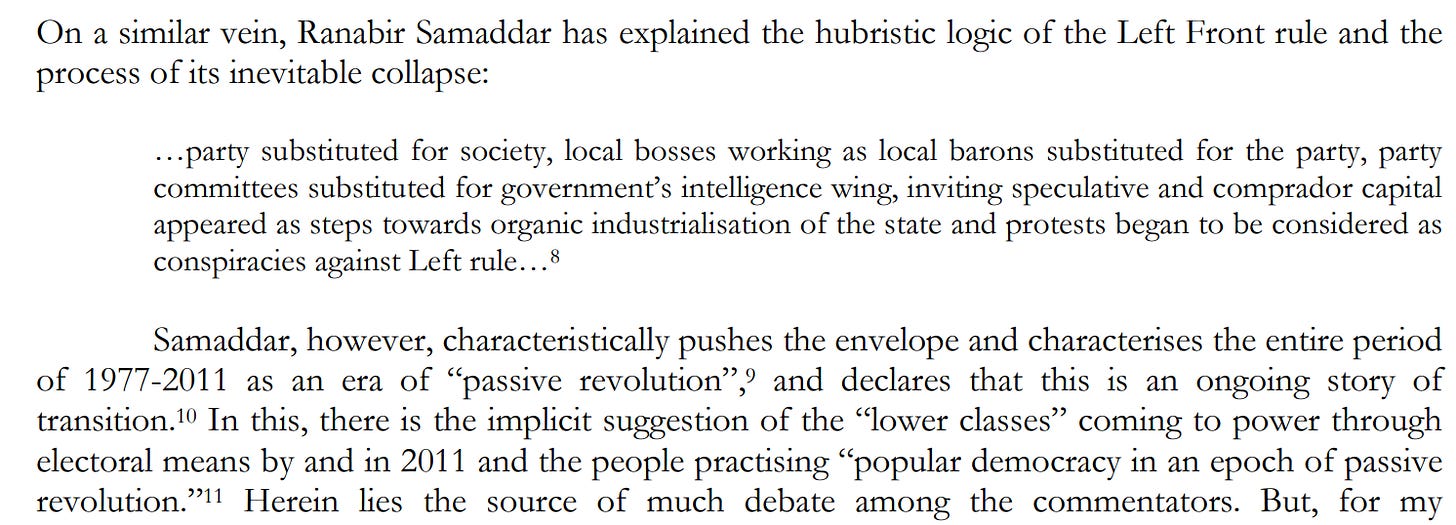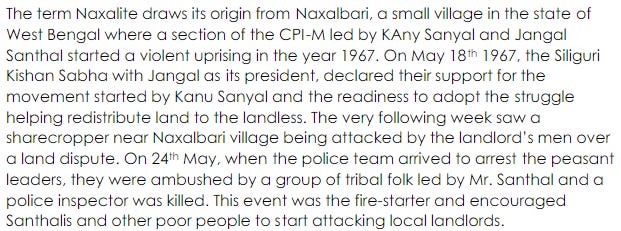Insightful newsletter of Drishtikone: Issue #212 - Rule of the Obnoxious
Insurgency conquest of a society is predicated on obnoxious dissent of the insurgent. Annihilation of the incumbent civilization requires it. Lessons from how Communists and Naxals destroyed Bengal.
Photo by James Wainscoat on Unsplash
“Strength and success - they are above morality, above criticism. It seems, then, that it is not what you do, but how you do it and what you call it. Is there a check in men, deep in them, that stops or punishes? There doesn't seem to be. The only punishment is for failure. In effect no crime is committed unless a criminal is caught.” ― John Steinbeck, The Winter of Our Discontent
When the first Christian century - the 5th century AD - began, the Church, which had hitherto played the role of insurgency was now bringing its agenda center stage. A society which would ‘render unto Caesar what was Caesar’s and to God what was Gods’, was now challenged. As Catherine Nixey writes in her seminal book “The Darkening Age,” Augustine asked people to revolt against the Roman law if it violated that of God - “to dissent and to become obnoxious to those who think differently,” was his call.
It wasn’t just enough to dissent. But to be obnoxious to those who think differently.
A revolt that is structured to take over a society cannot be complete unless it makes being obnoxious and abusive a legitimate expression against the incumbent social norms, beliefs, and customs.
When CPI(M) members hacked Pranab and Malay Kumar Sain in 1970 and forced their mother to eat rice smeared in her sons’ blood, the Communists were legitimizing hatred, abuse, and obnoxious ways against those who did not agree with them.
Yet, the state of Bengal tolerated these cadres and handed them the reigns of the state to lead it to its ruin.
For any civil society, and more so a civilization to survive and thrive, it is as critical to have intellectual guards as armed forces for security. For, Communism and Naxalism which was funded by India’s enemies should have been defeated at the very cradle of its birth through a strong and powerful intellectual challenge. Obnoxiousness should have been met by an equally potent force of intellectual dismission and physical challenge on the streets, where the whole play of murder was being unleashed.
That slumber. That self-loathing, self-delusional, and masochistic cynicism has become our national character now. The fight is now within if something useful has to be passed on to the coming generations.
How Communists destroyed West Bengal
As the Chinese attacked India in 1961, the Communist Party was going through an upheaval within.
After the war, 50+ Communist leaders had been thrown into jail. Interestingly, as per the CIA declassified papers, 4 radio sets were found in China Review in Calcutta to listen to the broadcasts from Peking (now Beijing).
Any guesses who those 50 Communist leaders in Bengal - that were colluding with the Chinese - were?
Well, three of them were Jyoti Basu, VS Achuthanandan, and Harkishan Singh Surjeet. (Source: South China Morning Post).
The year was 1962, the Communists had held China above Indian national interests. This understanding had taken ground within India. The tales of these Communist leaders in jail are instructive. (Source – Indian Express archive)
Some of these Communist leaders in jail wanted to derail any nationalist sentiment around them. So VS Achuthanandan (later became Kerala’s Chief Minister) suggested two ideas:
donating blood for the jawans
contributing money from the sale of prison rations saved by inmates to the defense kitty of the government
O J Joseph, who later became the Rajya Sabha member as well, rejected the idea. Communists would never donate blood for the Indian jawans!
When VS tried to bring up the matter again in the next meeting, a major scuffle happened between him and OJ.
Later VS dropped his plan.
The Communist leaders who were communicating with the Chinese during the 1961 war via the radio sets and carrying out the Chinese propaganda within India later became Members of Parliament and even the Chief Ministers of India’s two most progressive state!
Jaipal Singh, also known as Major because he was in the British Indian Army, was the head of the illegal organization within the Indian Army. He had decided to reactivate his organization in May 1961 following the hard left faction gaining control of the party. That is how the Communists infiltrated the Indian Army in the middle of the Indo-China war!
Review these CIA declassified documents for a better understanding of the role played by the Communists and also read “How Indian Communists committed Acts of Treason against the Indian state” – for a detailed discussion on how the Communists have undermined India.
1. The Sino-Indian Border Dispute Section 1: 1950-59
2. The Sino-Indian Border Dispute Section 2: 1959-61
3. The Sino-Indian Border Dispute Section 3: 1961-62
4. The Indian Communist Party and Sino-Soviet Dispute
The top 5 highlights of these documents:
HK Surjeet influenced by Russia to set up an underground organization
CPI did proceed to recruit a secret organization within the Indian Army
China Russia insisted that the CPI must develop a standby apparatus capable of armed resistance while intensifying penetration of Indian Military forces.
4 powerful radio sets had been installed in the office of the China Review in Calcutta to listen to broadcasts from Peking
China’s strategy was to use diplomatic channels to cut out the Indian press, public, and parliament. It was a 5-year masterpiece in guile. It played on Nehru’s Asian anti-imperialist mental attitude his proclivity to temporize and his sincerity for peace with China.
You can read a detailed article on this at Chinese media influence and Subversion of India
the Naxal movement
The Naxal movement started by using social inequities that were prevalent in Bengal - based on the landlords/zamindars who were propped up by the British for their revenue collection and land management. By pushing them while giving them unlimited powers, the British had turned them into a land-holding mafia with full force against the peasantry.
This was used as a ruse by the Naxals to start rural and then extend to the urban centers.
The Naxalite movement started in the summer of 1967 in northern Bengal and within a couple of years it spread across the entire province. A confrontation between the peasants and the landlords, followed by a clash between the peasants and the police, turned into a radical political movement that would dictate the politics of West Bengal for almost an entire decade. Led by the charismatic leader Charu Mazumdar—a dedicated follower of Mao Zedong—it was immensely popular among the peasants of Bengal. Mazumdar and his comrades believed in armed struggle as a means of revolution. They believed that the revolution would start from the villages and the peasants would be the main protagonists. They encouraged and inspired hundreds of the city’s students to join the peasant upsurge. Students from Presidency College, Maulana Azad College, Scottish Church College, Calcutta University, Jadavpur University, Calcutta Medical College, R.G. Kar Medical College and other important institutions left their studies and moved to the remote villages of Bengal to work with the peasants. (Source)
The Naxals started targeting everything that had to do with the pride of Bengal and the contribution of Bengalis in the Independent struggle and those who were nationalists.
Though the villages were to be the epicentres of the Naxalite movement, Calcutta soon emerged as a major site of Naxalite activities. Naxal presence was particularly strong in neighbourhoods such as Shyambazar, South Sinthi-Tobin Road, East Sinthi, Kashipur-Baranagar, Dumdum, Taltala, Entally Beleghata, College Street, Shobhabazar, Jadavpur, Tollugunj, Kashba, Behala, etc. Naxalites turned Calcutta into a virtual battlefield.[5] Naxal students targeted the ‘bourgeois education system’, questioned the glory of the Bengal Renaissance and the Indian nationalist movements, and attacked the representatives of the state they wanted to overturn. (Source)
The idea was to turn Bengal into a hotbed of anarchy and the center of anti-Indian sentiment.
As far back as 1970, the police in West Bengal knew that the Naxalites were terrorists.
“It's very difficult,” he explained, once we had settled comfortably in the bar, “to tell who are Naxalites and who aren't. You see, the tradition of terrorism has deep roots in Bengal, and today a lot of people besides Naxalites use terrorist tactics. These boys we arrested today are disaffected, and probably Communists of one shade or another, but what they are not is Naxalites. We can usually tell the Naxalites by the targets they choose, like schools and police posts, and by their techniques of attack. Bombs are their special favorite, of course. The manufacture of bombs is a cottage industry for them. They're dangerous, the bombs, because, of course, they're unexpected. The Naxalites come out of nowhere and throw them. You don't see them till they explode.” (Source)
The Naxalites led a double life. On the outside, they were all for peasants and the revolt by the peasantry, but in real life, they were something else. Charu Mazumdar, for example, owned shares in tea plantations, was addicted to illicit liquor, and a worshipper of Kali.
Oh, he's in Calcutta, I'm perfectly sure of that. He needs to be in a city, where he can be looked after by a doctor. He's addicted to illicit liquor, too, of course, which can't be very good for him in his state of health. He's a worshiper of Kali, you know, the goddess of death. For the last few years he's been translating the writings of Che Guevara into Bengali. He leads a pretty busy life, but he can always retire peace fully to the countryside. He owns shares in a tea planta tion in Naxalbari.” (Source)
Similarly, some of the corporate executives were working along with them.
The executive officer of Indian Aluminium, Tapan Mitra, a highly qualified man, recently turned out to be a Naxa lite, and he was arrested. (Source)
Who was backing these Naxalites and who created them? Here is another 1970 article from the New York Times, when it was still a newspaper and not a leftist tabloid.
The Naxalites are a pro-Peking Communist group that appeared three years ago, leading an abortive armed revolt of landless peasants in the Naxalbari District. In the last year they have taken advantage of political chaos to burn, bomb, kill and spread fear in a drive to destroy the established system in the name of Chairman Mao Tse‐tung.(Source)
The reasons why the Naxal “movement” had picked on were partly orchestrated internally and partly because of the entire chaos in Bangladesh prior to the 1971 war.
The conditions that bred the Naxalites — unemployment, bursting shanty slums, an in flux of impoverished Hindu refugees from East Pakistan, the flight of industry and the breakdown in city services such as transport and sanita tion—continue to deteriorate.(Source)
What was started by the Communists was amped up by the Naxals.
This was the time when stores, restaurants, and movie-halls after dark would be deserted. Doctors had stopped taking night calls. There was a general sense of insecurity and scare around Calcutta.
The ways of the Naxals were very brutal.
Some of the attacks have been incredibly bloodthirsty. A Left Communist teacher was stabbed in her classroom by a Naxalite band. Another group dragged a 15‐year‐old school boy who had been trying to break his Naxalite ties out of his classroom and stabbed him to death. (Source)
The whole governance in Bengal was compromised. The integrity and the very basis of democratic institutions were bastardized by the Left. And, if anyone carried out as much as a protest against this subversion, it was dismissed as “conspiracy against the Left rule.”

That is how the Communists started - by seeding the Naxals and building up on the misery of rural peasantry to create a large base in urban centers, specifically Calcutta. They subverted the educational institutions and coopted the students from the top universities and colleges to become Naxals. If they didn’t then they were murdered if they were prominent and did not fall in line.
Businesses were slowly destroyed. Businessmen were killed, kidnapped, or threatened. Destruction of industry, lack of new start-ups, and ventures closed all avenues of jobs and incomes. A heady mix for Naxal and Communist breeding ground.
The same formula is being tried in other areas in India as well.
America is up for sale
We have seen how the Biden administration has basically become an obedient puppy to the Chinese. The Chinese vassal state Pakistan has also been working hard on infiltrating the US apparatus. We saw how they have been trying to influence the think-tanks in the US.
But the rot is much deeper.
Recently a non-profit “True the Vote” in Nevada asked for the Nevada voter registration list from Nevada’s Secretary of State office. It received it. But with a cc: to a Pakistani company employee. Kristina Wong wrote about this (Source)
This company Kavtech seems to have deep links with the Pakistani intelligence agency ISI and the Pakistani army.
“The address was waqas@kavtech.net. Waqas Butt is the CEO of Kavtech Solutions Ltd.. Kavtech is a Pakistani owned company, located in Lahore, Punjab, Pakistan, with ties to Pakistani intelligence, military, and the interior,” she wrote. Election researchers aware of the situation said the inclusion of the email could be anything from an accident by a contractor who worked on the Nevada secretary of state’s website, to an indication of an unauthorized intrusion into the backend of the state government website’s system by a company allegedly linked to Pakistan’s Inter-Services Intelligence (ISI). (Source)
Basically, American democracy is up for sale. Even Pakistan can buy it now.
market corner: 10 quick bytes
India-dedicated funds pulled out $9.1 billion until November, shows data - more
Meanwhile, Investor wealth rises Rs 8.22 lakh crore in four trading sessions on a bullish market - more
False narratives about the new farm laws are doing significant harm to the interest of farmers as well as the economy in general, Niti Aayog Vice Chairman Rajiv Kumar said on Monday and expressed his disappointment at some economists changing their stance on the new legislation - more
India's light vehicle market shrinks 22-25% in 2020; drops out of top 5 markets - more
Retailers estimate 85% recovery by June 2021, says apex body Retailers Association of India (RAI) - more
The export subsidy, rise in ethanol price to increase the operating margin of sugar mills in FY21: Report - more
RBI says 37.91% of loans were under moratorium as of August-end - more
Indian Railways journey to get more scenic: ICF develops new high-speed Vistadome coaches - more
Flipkart Wholesale app logs 75% month-on-month growth in customer base - more
30% of businesses still disrupted, the vaccine could lead to a faster turnaround: Dun & Bradstreet - more
nota bene
Army Chief in Korea: Army chief General Manoj Mukund Naravane on Monday kicked off a three-day visit to South Korea to bolster military cooperation with the East Asian country, the first by an Indian Army chief, the army said in a statement. This is Naravane’s fifth visit to a foreign country during the Covid-19 pandemic after Myanmar, Nepal, United Arab Emirates, and Saudi Arabia. (Source)
China brokering Nepal Communist battles: A top Chinese official met leaders of a faction of the Nepal Communist Party opposed to Prime Minister KP Sharma Oli on Monday even as Beijing called on the leadership in Kathmandu to manage differences and ensure political stability. Guo Yezhou, the vice-minister of the international department of the central committee of the Communist Party of China (CPC), who arrived in Kathmandu on Sunday afternoon, met separately with former prime ministers Pushpa Kamal Dahal “Prachanda” and Madhav Kumar Nepal, both rivals of Oli in the ruling party. (Source)
Illegal Arms bust in Haryana and UP: Moving ahead in Sirsa’s illegal arms recovery case, Haryana Police on Monday claimed to have busted an illegal arms manufacturing unit in Uttar Pradesh and recovered a large quantity of equipment used in making illegal weapons. A Haryana Police spokesperson informed that the crackdown was made by a CIA team at the behest of kingpin Istaq Ahmed, a resident of Bazar Mohalla, Baheri, district Bareilly in UP, who was arrested in connection with the recovery of huge illegal arms in Sirsa. The illegal unit was busted by police during a raid in the Beheri area in UP. (Source)
100 Blue Flag Tag beaches: India has set an ambitious target of getting the coveted Blue Flag tag for its 100 more beaches in the next three years. At present, the country has eight such beaches, recognized as clean, safe, and environment-friendly marine sites. The Blue Flag certification is a globally recognized eco-label accorded by the Foundation for Environment Education in Denmark, based on 33 stringent criteria relating to environmental, bathing water quality, education, safety, services, and accessibility standards. (Source)
China silences Citizen Journalist from Wuhan: A Chinese court imposed a four-year prison term on a citizen journalist who documented how Covid-19 ravaged the city where the coronavirus was first detected, in a case that underscores the lengths to which Beijing has defended its official narrative of the pandemic. Zhang Zhan, 37 years old, was convicted of “picking quarrels and provoking trouble” after a roughly 2½-hour trial at the Shanghai Pudong New Area People’s Court on Monday, where prosecutors accused her of spreading falsehoods about the coronavirus pandemic through social-media posts and interviews with overseas media, her lawyers said. (Source)
video corner: how to create solid mercury lingam
Praveen Mohan is a single man army. He goes around ancient Indian temples and monuments and looks at them in very different ways. Some of his videos are truly unique. I have seen solid mercury lingams myself, even when we know mercury cannot exist at room temperature. Here this guy - based on his understanding from different sources - shows us how it can be done. Worth watching!
Today’s ONLINE PAPER: Check out today’s “The Drishtikone Daily” edition. - THE DRISHTIKONE DAILY
TOOLS WE USE (our secret recipe): Here are some tools we use to streamline our work and do things in a lean and agile manner.
Evernote: One-stop shop for all note-taking and content clipping - this tool has notes, articles (~10,000) saved since 2005 which go into our research (have used their premium plan - very powerful!) // Fiverr: Get everything done by professionals for much less money. The most important marketplace for great talent! // Grammarly: your personal grammar checking tool (indispensable for writers)// Ferns n Petals: Send cakes, flowers, gifts, rakhis in India (tried and tested for 5 years!) // Sling TV: throw out the expensive cable and dish TV and get the same channels for less // Bluehost (US): Cheap and powerful website hosting (start a site for just $3.95/month - for India use this link -> Bluehost-India to start a site for $199/month) // Headliner App: Create amazing videos from the podcast/audio files with FB/Twitter integration (get 2 weeks free) - we use it for our podcasts
[These are referral links - which may provide us with some consideration at no cost to the user]
SUPPORT DRISHTIKONE: If you consider our work important and enriching and would like to contribute to our expenses, please click on the button below to go to the page to send in your contribution. You can select the currency (for example, INR or USD, etc) and the amount you would like to contribute. Contribute to Drishtikone
If you like this post - please share it with someone who will appreciate the information shared in this edition
If you like our newsletter, please share it with your friends and family







